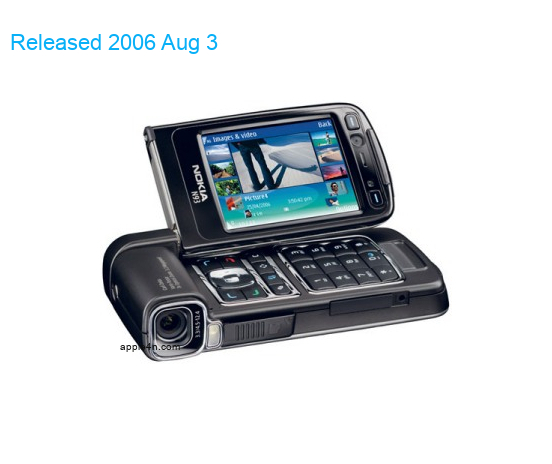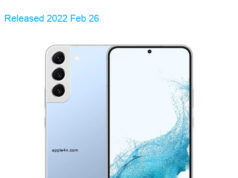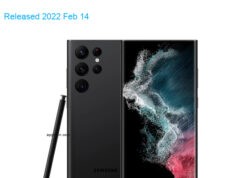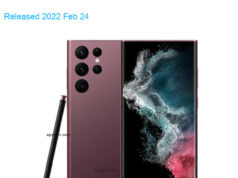| Brand | Nokia |
| Model | N93-5 |
| Released | 2006 Aug 3 |
| Hardware Designer | Nokia |
| Manufacturer | Nokia |
| OEM ID | RM-153 |
| Device Category | Smartphone |
| Width | 55.5 mm |
| Height | 118 mm |
| Depth | 28.2 mm |
| Dimensions | 2.19×4.65×1.11 inches |
| Mass | 180 g |
| Platform | Symbian |
| Operating System | Symbian OS 9.1 Series 60 3rd Edition |
| CPU Clock | 332 MHz |
| CPU | Texas Instruments OMAP 2420, 2005, 32 bit, single-core, 32 Kbyte I-Cache, 32 Kbyte D-Cache, 90 nm, IMG PowerVR MBX GPU |
| RAM Type | SDRAM |
| RAM Capacity (converted) | 64 MiB RAM |
| Non-volatile Memory Interface | Yes |
| Non-volatile Memory Capacity (converted) | 128 MiB ROM |
| Display Diagonal | 61 mm |
| Resolution | 240×320 |
| Horizontal Full Bezel Width | 18.9 mm |
| Display Area Utilization | 27.3% |
| Pixel Density | 167 PPI |
| Display Type | Color TN-TFT LCD display |
| Number of Display Scales | 262144 |
| Scratch Resistant Screen | No |
| Secondary Display Diagonal: | 28 mm |
| Secondary Display Resolution | 128×36 |
| Secondary Display Pixel Density (dot pitch): | 121 PPI |
| Secondary Display Type: | Color TN-TFT LCD 2nd display |
| Secondary Number of Display Colors/Scales: | 65536 |
| Graphical Controller | PowerVR MBX |
| A/V Out | Yes |
| Microphone(s) | stereo |
| Loudspeaker(s): | mono |
| Audio Output: | Proprietary |
| Supported Cellular Bands | GSM900 , GSM1800 , GSM1900 bands |
| Supported Cellular Data Links | CSD , HSCSD , GPRS , GPRS MSC11 , EDGE , EDGE MSC32 data links |
| SIM Card Slot | Mini-SIM (2FF) |
| Complementary Phone Services | Voice transmission , Voice speaker , Vibrate , Speakerphone , ANC |
| Sec. Supported Cellular Networks: | No |
| Keyboard | Built-in numeric |
| Number of keys | 20 |
| Directional Pad | 5-way |
| Expansion Interfaces | SDIO , miniSD |
| USB | USB 2.0 |
| USB Connector | Proprietary |
| Bluetooth | Bluetooth 2.0 |
| Wireless LAN | No |
| IR | IrDA 1.2 |
| FM Radio Receiver | FM radio (88-108 MHz) |
| Camera Placement | Rear |
| Camera Image Sensor | CMOS |
| Number of effective pixels | 3.1 MP camera |
| Zoom | 3.0 x optical zoom |
| Focus | CD AF |
| Video Recording | 640×480 pixel |
| Flash | single LED |
| Camera Extra Functions | Macro mode |
| Aux. Camera Image Sensor | No |
| Aux. 2 Camera Image Sensor | No |
| Aux. 3 Camera Image Sensor | No |
| Aux. 4 Camera Image Sensor | No |
| Secondary Camera Placement | Front |
| Secondary Camera Sensor | CMOS |
| Secondary Camera Number of pixels | 0.1 MP sec. cam |
| Secondary Video Recording | 176×144 pixel |
| Sec. Aux. Cam. Image Sensor | No |
| Built-in accelerometer | No |
| Protection from solid materials | Yes |
| Protection from liquids | Yes |
| Battery | Li-ion polymer (LiPo) |
| Nominal Battery Capacity | 1100 mAh battery |
| Estimated Battery Life | 13.0 hours |
| Market Countries | China , HK , Singapore , Taiwan |
| Market Regions | Asia , Southeast Asia |
| Price | 29500 unknown |
| Added | 2025-01-31 |
Specifications data description of this 📱Nokia N93-5📱
Title: Nokia N93-5: A Comprehensive Look at the Specifications 📱
Introduction
————
In this blog post, we will be exploring the specifications of the Nokia N93-5, a device that has left its mark on the mobile phone industry. From its network capabilities to its memory and camera features, we’ll provide a detailed overview of the device’s key features.
Lineup
——
Released in 2007, the Nokia N93-5 was part of Nokia’s Nseries, a lineup of high-end smartphones designed for multimedia use. The Nseries offered advanced features such as high-resolution cameras, large screens, and enhanced multimedia capabilities, attracting users who prioritized media consumption and creation.
Design 🏋️
——–
The Nokia N93-5 boasted a sleek and sturdy design, with dimensions of 118.2 x 55.5 x 28.2 mm and a weight of 180 grams. The device was available in a single color: graphite black. Its foldable design allowed for dual functionality as both a mobile phone and a camcorder, providing users with an innovative and practical device for their daily needs.
🌐 Network
———
The Nokia N93-5 was compatible with GSM networks on quad-band frequencies of 850, 900, 1800, and 1900 MHz. Additionally, it supported 3G UMTS networks on the 2100 MHz frequency, providing users with both voice and data services at faster speeds.
📅 Launch
——–
The Nokia N93-5 was announced in January 2007 at the International Consumer Electronics Show (CES) and became available for purchase later that year.
🌈 Display
——–
The Nokia N93-5 featured a 2.4-inch QVGA display (240 x 320 pixels) with a 16:9 aspect ratio and support for up to 16 million colors. The device’s screen was protected by scratch-resistant mineral glass, enhancing its durability.
🤖 OS 🛠️
——
Powering the Nokia N93-5 was the Symbian operating system, specifically, the Symbian OS 9.2 with the S60 3rd Edition Feature Pack 2 user interface. The OS offered users an intuitive interface with a wide range of applications and features.
🚀 Chipset 🔧
———
The Nokia N93-5 used the TI OMAP 2420 chipset, which combined an ARM1136JF-S CPU clocked at 330 MHz with an Image3D Imaging Accelerator for improved multimedia performance.
💪 CPU 🖥️
——
The ARM1136JF-S CPU provided users with a powerful central processing unit, improving the device’s overall performance and enabling smoother multitasking and media consumption.
🎮 GPU 💻
—–
The GPU of the Nokia N93-5 was the PowerVR MBX Lite, a dedicated graphics processing unit designed for 2D and 3D graphics acceleration. This GPU allowed the device to display high-quality visuals in the device’s interface and supported applications.
🧠 MEMORY 🗂️
———-
The Nokia N93-5 housed 64 MB of RAM and 128 MB of ROM for internal storage. Users could expand the device’s storage capacity with a microSD card, up to 2 GB at the time of release.
📷 CAMERA 🎥
———
The Nokia N93-5’s primary camera was a 3.2-megapixel Carl Zeiss Tessar lens with a 2048 x 1536 pixel resolution. It offered features such as autofocus, a Carl Zeiss Vario-Tessar lens, 3x optical zoom (2x lossless), dual-LED flash, and video recording at 30 frames per second. Additionally, the device boasted a secondary camera with a QVGA resolution for video calling.
🔈 SOUND 🎵
——–
The Nokia N93-5 offered users an immersive listening experience with its built-in dual speakers and stereo sound. It also provided support for a variety of audio formats such as AAC, MP3, WMA, and M4A.
📡 COMMS 📶
——-
In terms of connectivity, the Nokia N93-5 featured Bluetooth 2.0 with EDR, Infrared, Wi-Fi (802.11b/g), and micro USB. It also offered users a 3.5 mm audio jack for personal audio devices.
💡 FEATURES 🎁
———-
Other notable features of the Nokia N93-5 included:
* TV-out support
* Integrated GPS
* Push-to-Talk (PTT)
* UPnP (Universal Plug and Play) support
* Flash Lite 2.0
* Java MIDP 2.0
🔋 BATTERY🔌
——–
The Nokia N93-5’s removable Li-Ion 1100 mAh battery (BL-5F) provided up to 3.5 hours of talk time and up to 10.5 days of standby time.
Conclusion
———-
The Nokia N93-5 was a versatile device catering to the needs of mobile phone users in 2007, offering a wide range of advanced features and functionality. Its powerful hardware, multimedia capabilities, and expandable storage made it an attractive option for users seeking a high-quality smartphone.
Please feel free to leave your comments and share your thoughts on the Nokia N93-5 in the comments section below! 💭📝








